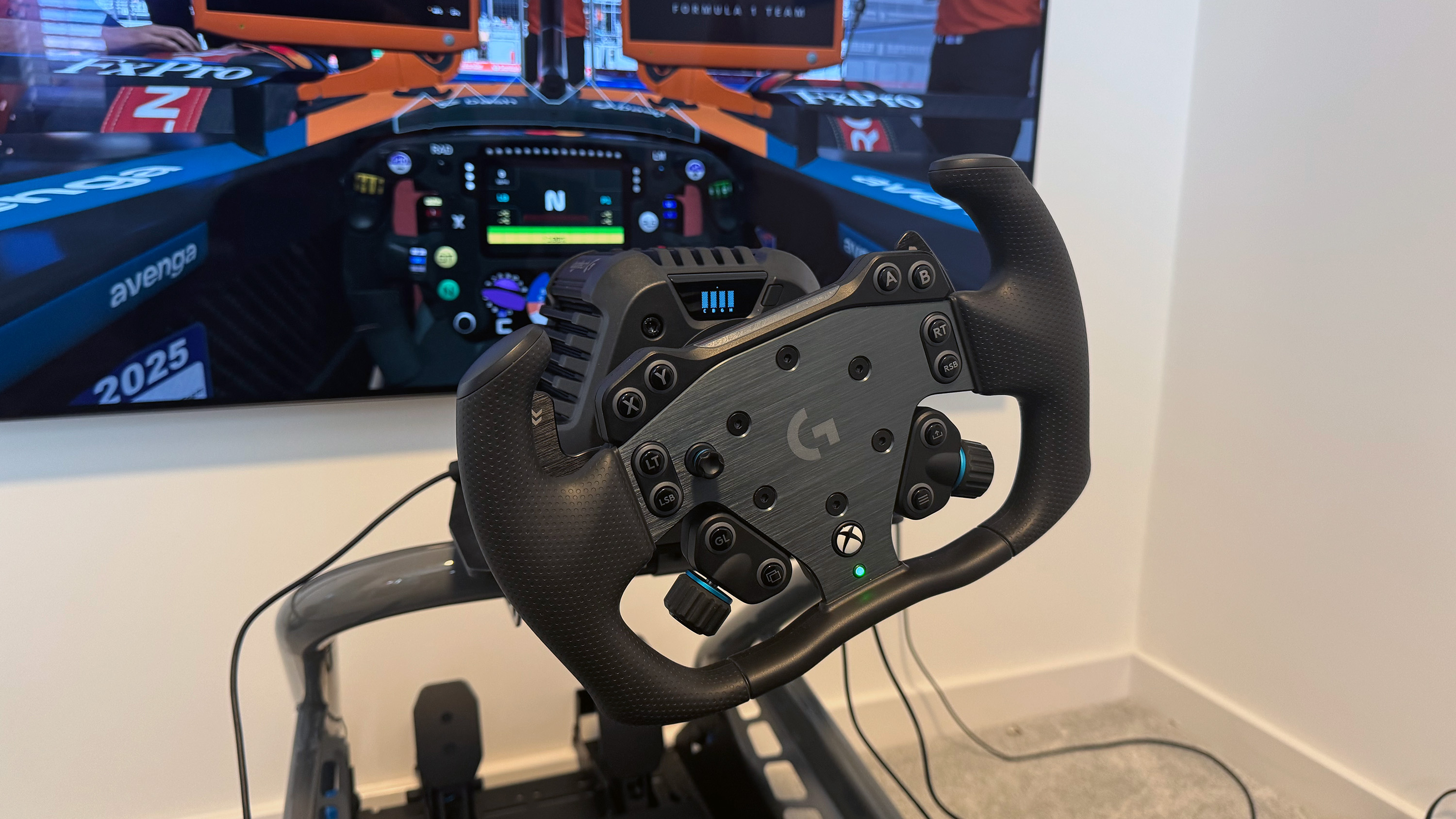GamesRadar+ Verdict
For a majority of sim racers, it’s not going to come much better than the Logitech RS50. It keeps the best bits of the brand’s premium wheelbase and only lifts the throttle slightly to keep costs reasonable. It’s high quality and high performance, just make sure you’re getting the best value bundle before checking out.
Pros
- +
Smooth, reliable 8Nm direct drive motor
- +
TRUEFORCE is immersive
- +
Strong build quality
- +
Competitively priced
Cons
- -
G Hub offers limited tuning options
- -
No all-in-one bundle option
Why you can trust GamesRadar+
While there are plenty of brands focused on sim racing gear, it’s Logitech that has long been a go-to option for casual fans. The G923 was, and probably still is, one of the most popular entry-level options for anyone looking for one of the best racing wheels for PC, but it’s now slipping through the midfield as technology advances. The Logitech G Pro Racing Wheel arrived a couple of years ago and does an excellent job at the premium end of the grid, but there has always been an awkward gap on the price ladder where Logitech simply didn't compete.
Previously, if you wanted a mid-range, direct drive option, you’d have to look to brands like MOZA, Thrustmaster, or Nacon’s new Revosim gear. But now Logitech has an answer with its latest wheel, the RS50. This delivers 8Nm of direct drive torque in a $699/£599 bundle with wheel and hub. With TRUEFORCE, a wider Logitech ecosystem of add-ons, and compatibility with PC, PlayStation, and Xbox, it looks like an exciting new contender, especially for fans of the G920 series who want to graduate to something new.
But has Logitech left it too late and been overtaken by rivals? More and more brands are now competing in this mid-price, mid-spec division, so competition is strong. Is the RS50 destined to be a TRUEFORCE to be reckoned with?
Design
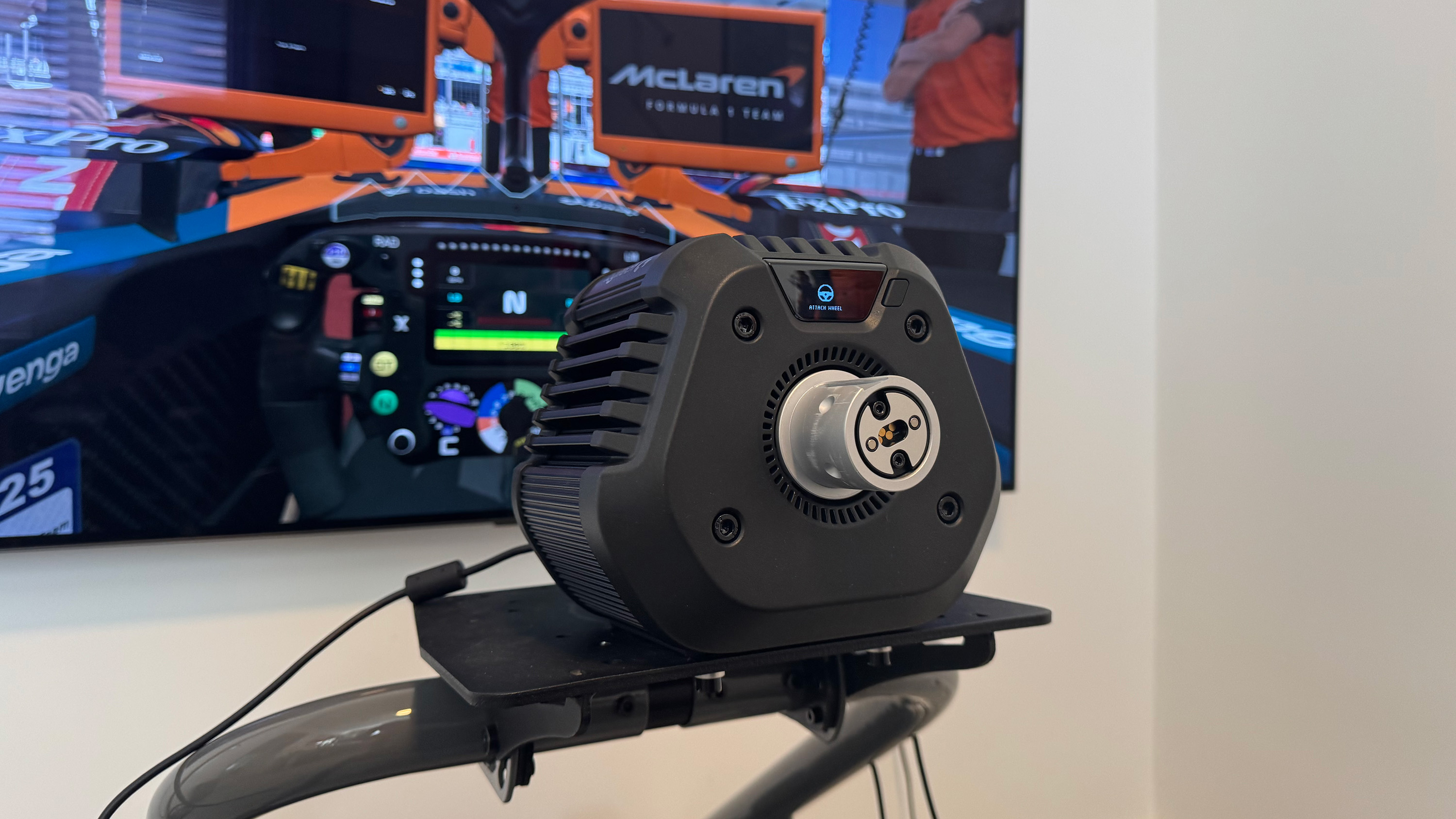
Anyone who’s ever taken an interest in Formula 1 knows that while there’s always room for minor differences from team to team, over time, the design of each car becomes largely the same. That’s because ultimately there’s always a ‘right’ answer to the design challenge, and the RS50 shows Logitech has been peeking into the garage of its competitors and taking notes.
8Nm of power is plenty, particularly when it’s delivered as reliably as it is here, with the added immersive bonus offered by TRUEFORCE in some titles.
Gone is the oversized, melted pyramid Logitech opted for with the original G Pro wheelbase. Instead, it’s replaced by a much smaller body that gives in to peer pressure and accepts the sim racing standard of a compact, finned cube.
There’s still room for personality though, and the RS50 has a couple of charmingly sloped sides and rounded corners that give it a unique look overall. These changes make the RS50 feel much less industrial than its rivals too; it’s the fun one of the group. The front of the wheelbase retains the small but useful OLED from the G Pro and a rear three-port USB hub for expanding your sim racing ecosystem with additional accessories. The bulk of the RS50’s construction is metal, and while there’s a little more plastic here than you’ll see on others like the MOZA R12, build quality is excellent across the board. From the first time you lift it out of the box, there’s no doubt this is a premium bit of kit.
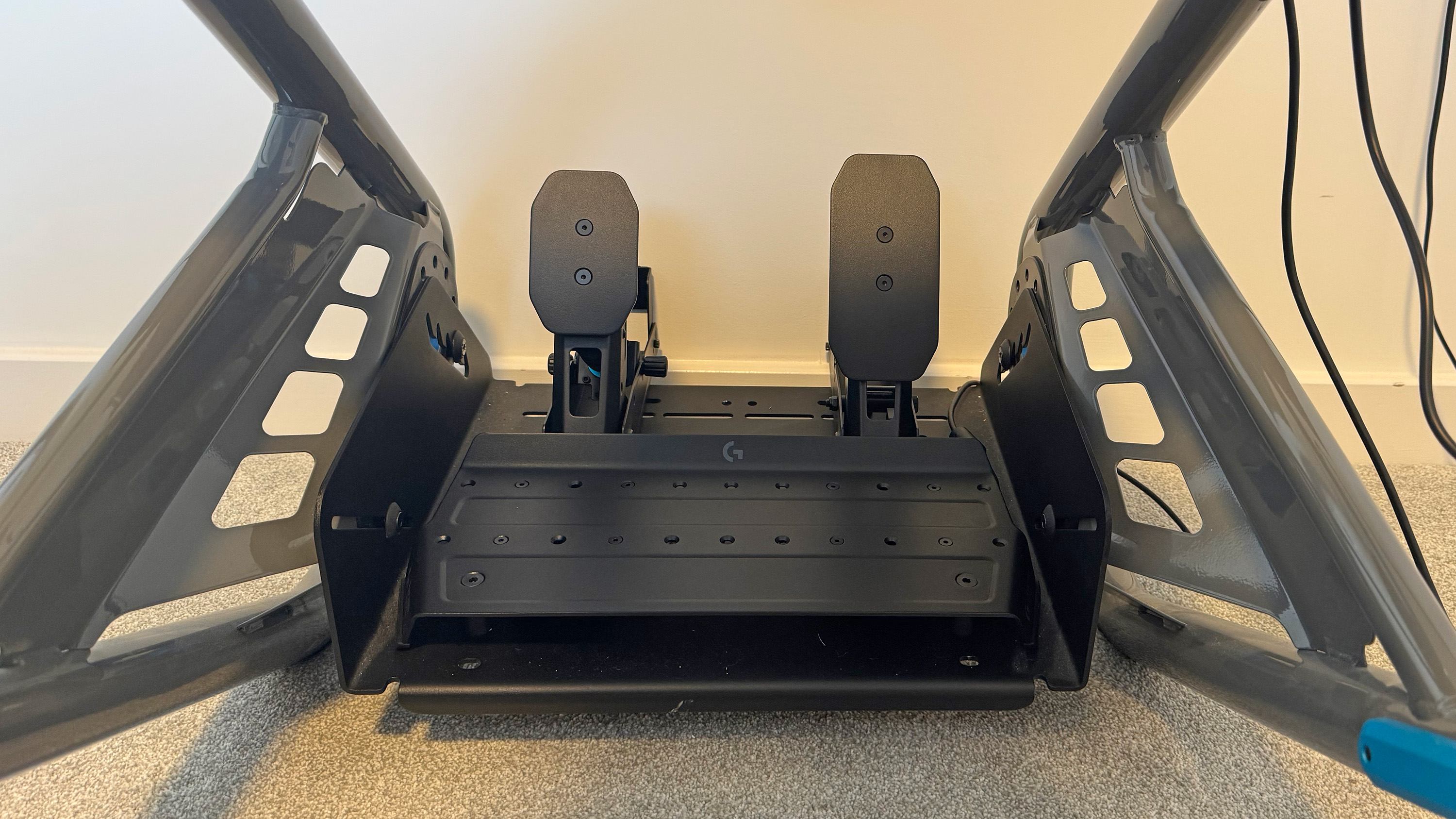
The new RS Pedals tell a similar story, with Logitech moving away from its previous philosophy and opting to fall in line with other brands. Where the G Pro Pedals opted for a large, all-in-one style tray, the RS variant is DIY with individual pedals and a separate heel plate. This means far more fiddling when putting the set together, and less overall adjustability, but with all the hex screws tightened up, I had no concerns with strength or longevity. If you’re using a racing seat like the Playseat Challenge X the RS Pedals will bolt straight to the tray with predrilled holes in the usual places. If you’re not, Logitech has included both carpet grips and wall braces, which is a thoughtful touch for desk racers.
Weekly digests, tales from the communities you love, and more
You’re down to just a brake and accelerator in the box as standard, though you can add a clutch pedal as a separate module if you’re that way inclined. It’s metal across the board here, and while build quality is decent, it feels noticeably pared back compared to the G Pro wheels. Everything is just a touch smaller and a touch less beefy; it’s like the step down from an F1 car to F2. It’s understandable with the RS Pedals coming in at less than half the price, and more importantly, they’re neatly in line with rival price point options like the Revosim RS Pure.
Features
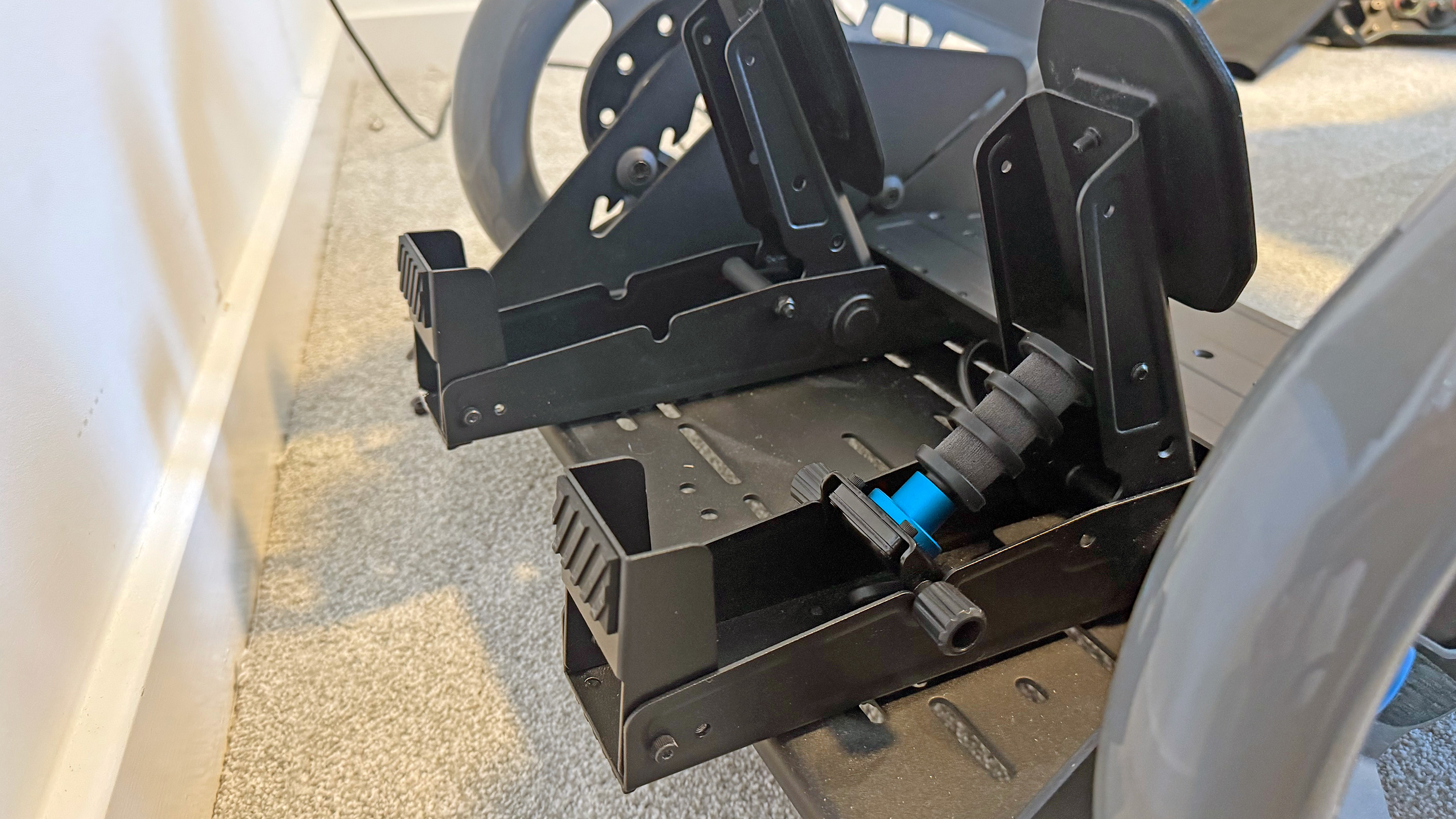
The RS50 wheelbase packs a direct drive motor with up to 8Nm of torque and realistically, that’s going to be plenty for the vast majority of hobbyist sim racers. If you’re considering this as an upgrade from the gear-driven Logitech G923 or any non-direct-drive wheel, there’s no need to be chasing the highest power possible, because the difference is already going to be massive. There’s TRUEFORCE support onboard here too, Logitech’s proprietary layer on top of traditional force feedback that adds a greater level of detail and realism by relaying more information from the game in supported titles.
The RS50 is wonderful, and I’d probably go as far as to say out of all the sim racing gear I’ve tested, it’s my favorite wheelbase.
I was particularly impressed with the mounting experience of the RS50. I paired it with the Playseat Trophy Logitech G Edition, and while, like the Nacon Revosim RS Pure, it relies on t-nuts, Logitech includes a clever plastic guide rail that keeps them lined up with the wheelbase itself. It took away all the frustrations I faced with the RS Pure and made mounting the Logitech RS50 quick and simple. If you’re not using a cockpit, Logi offers a table clamp, but this is only included with the ‘RS50 System’ bundle. However, if you opt for the wheelbase on its own because you don’t need the Logitech G RS Wheel Hub and rim, you’ll need to grab that as an added extra.
The RS Pedals may look simple, but there’s plenty going on underfoot. The throttle uses a contactless Hall effect sensor for increased precision and longevity, while the brake relies on a 75kg load cell. This load cell measures how hard you press the brake pedal, not how far you move it. It’ll take some getting used to, but it makes advanced driving skills like trailbraking far easier to master. Logitech includes a handful of different polymers to dial in the resistance here, though the default settings will likely suffice for most.
Compatibility
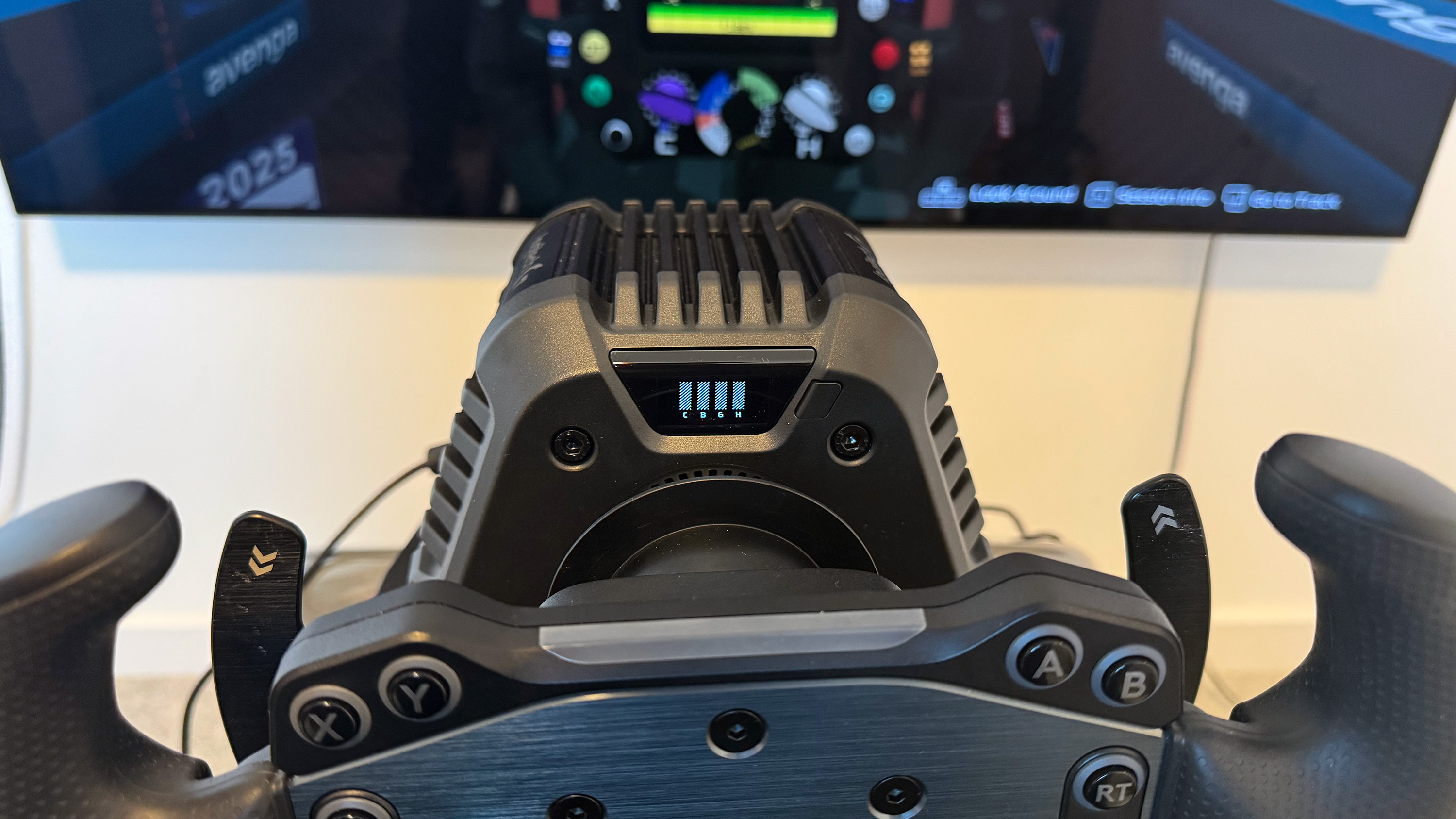
Before we head out on track, we need to briefly touch on compatibility, the wider Logitech ecosystem, and the available bundle options because they are… curious.
Build quality is excellent, there’s an expanding ecosystem of add-ons, including those impressive load cell RS Pedals, and it’ll play nice with consoles too if you grab the right edition.
The new wheelbase is available in two ways: either on its own as the RS50 Base ($349-449/£249-339), or as the RS50 System bundle. The latter also includes the desk clamp, RS Wheel Hub, and the RS Round Wheel, and lifts the price to $699/£599 which is somehow more expensive than adding the individual components to your cart. Notably absent from the ‘bundle’ are the RS Pedals, which you’ll need to grab separately for $159/£119, and there’s no bundle option featuring the RS Track Wheel.
There are PC or PlayStation/PC compatible versions of the RS50 Base, while either can also be made Xbox compatible by using the Xbox version of the RS Wheel Hub. Other Logitech racing equipment should play nice across the board via the USB hub on the back of the base or with the Racing Adapter, so you could carry forward your G920 pedals or add on something like the RS Shifter and Handbrake.
If you owned the original G Pro wheel, that’ll slot straight on to the RS50’s quick-release mechanism, and I had no problems freely switching between the new RS Wheel Hub and the old G Pro wheel from game to game.
Performance
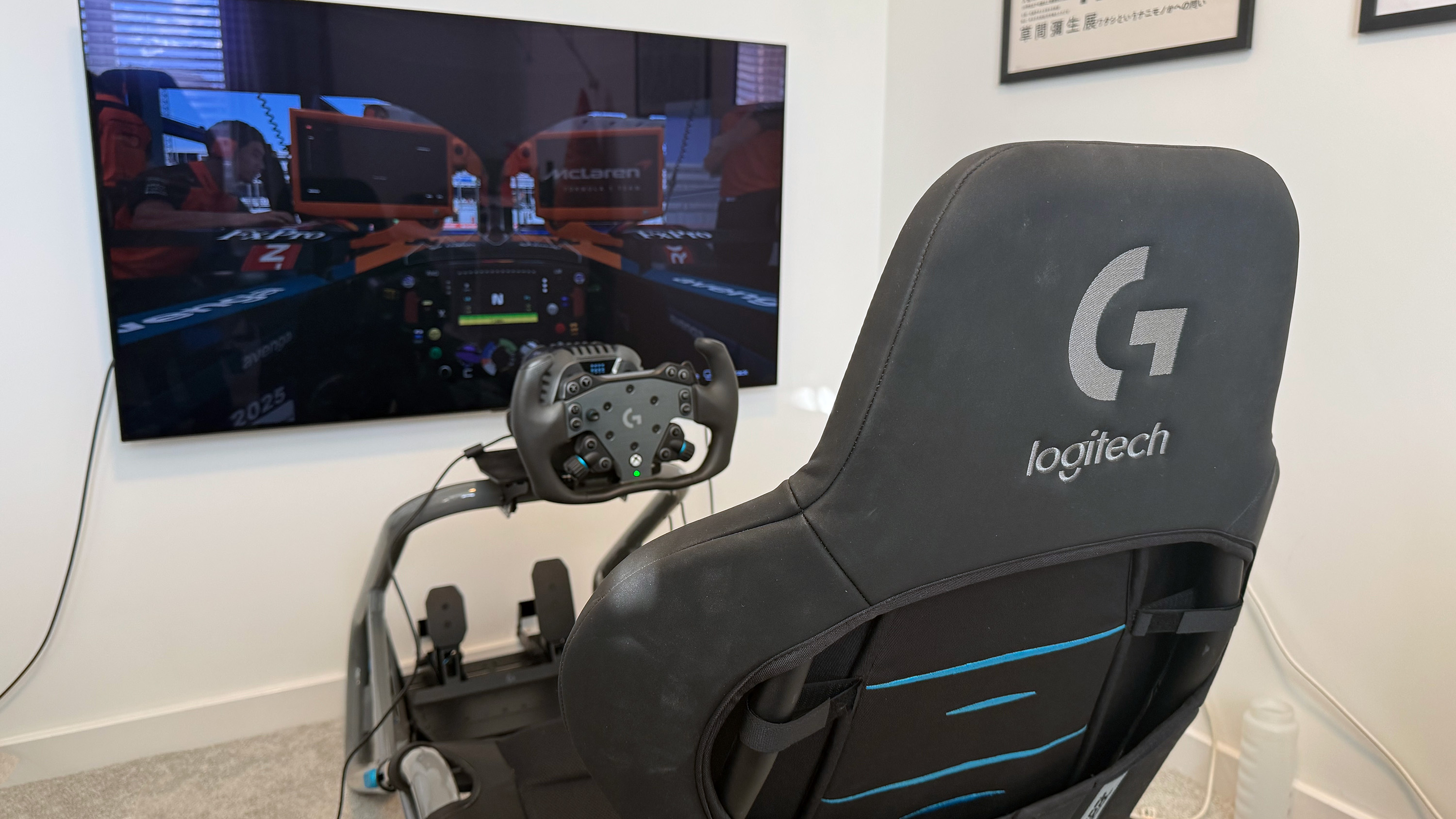
I’m a big fan of the RS50’s older sibling, the Logitech G Pro Racing Wheel which first arrived at the end of 2022. It was my daily driver (pardon the pun) for a long time, and truth be told, if it wasn’t such a beefy unit, it would probably have still been my daily driver now. That’s why I’m so pleased with what Logitech has been able to deliver with the considerably smaller RS50. For my mid-range sim racing ability, the Logitech RS50 delivered every bit of performance and enjoyment I wanted it to.
The RS50 is wonderful, and I’d probably go as far as to say out of all the sim racing gear I’ve tested, it’s my favorite wheelbase. The 8Nm of direct drive torque lands in a real sweet spot of wrestling me without wanting to rip my arms off. It’s a similar experience to the Revosim RS Pure, but stacking TRUEFORCE on top makes a surprising difference. Only certain games support it, but in F1 25, it delivered a serious immersion boost. Different surfaces felt unique, and even individual kerb types resulted in noticeably different sensations. It’s one of those things that you probably aren’t missing out on if you already have a direct drive wheel without TRUEFORCE, but a feature you’ll prioritize keeping once you’ve had it.
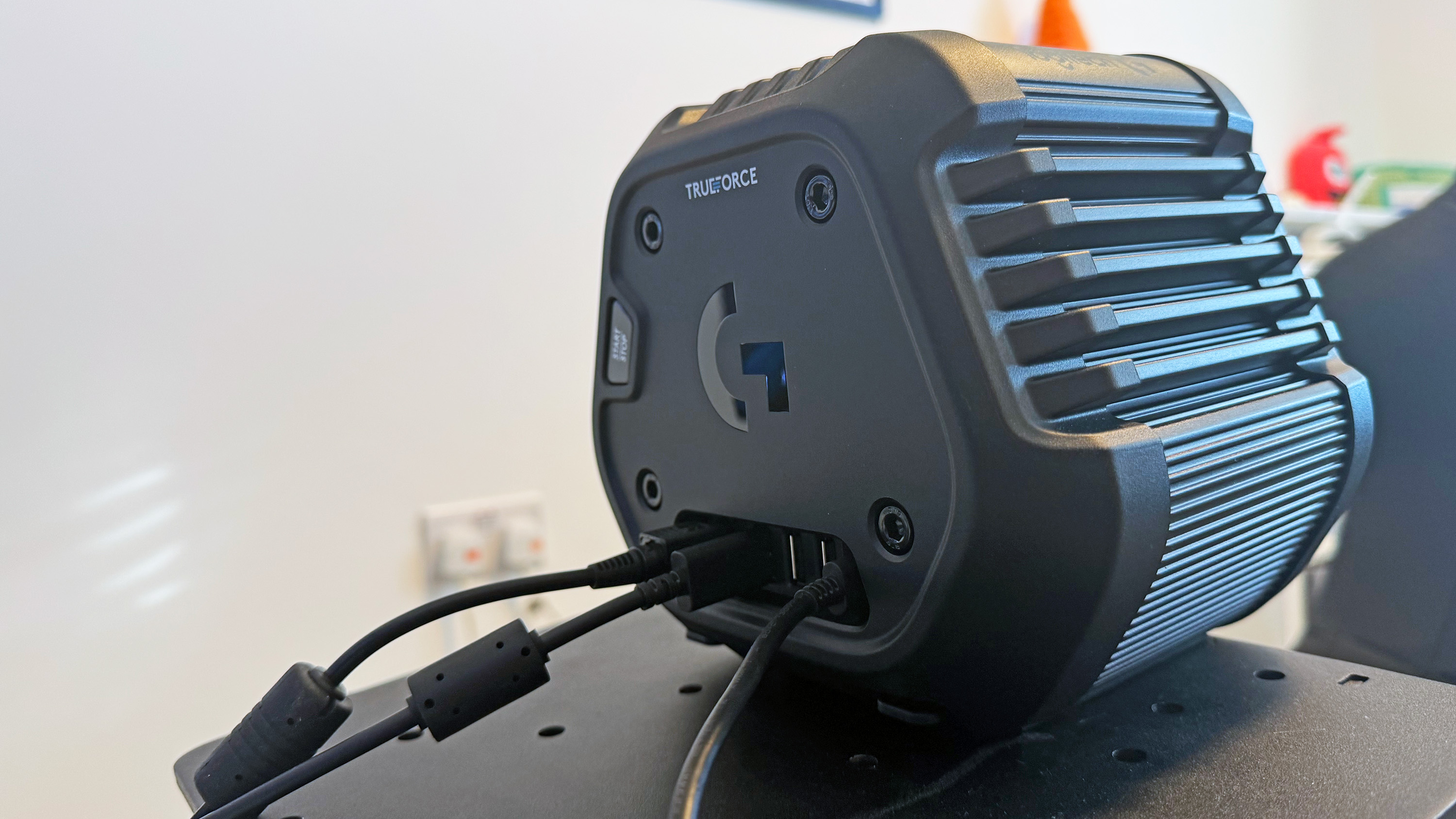
Overall, the power delivery was smooth and consistent from game to game, and through a few hours of testing, I didn’t notice a drop off in performance or any strange feelings of noise or grain creeping into the force feedback. Curiously though, in my setup at least, it felt as though the Logitech RS50 was delivering force feedback down through its base, rather than into the wheel. Mounted on my Playseat Trophy, there was noticeably more vibration and rattle going across the frame and down into the seat than I’ve experienced before with other wheelbases. It made things slightly louder, but in a strange way, it felt more engaging too. The energy wasn’t just being shot straight up my arms; it was coming up from the seat underneath me. Whether this is just a quirk of my specific mounting setup, I’m unsure, but I’m not mad about it.
Heading to the floor, the RS Pedals do their job admirably and without much fuss or fanfare. They’re just as good as similar offerings like the MOZA R12 or Revosim Pure bundle, with plenty of fine detail and control on the throttle and reliable performance under braking. Much like the 8Nm of torque in the wheelbase being enough for me, the 75kg load cell in the brake pedal is plenty. It’ll take a serious nudge to max it out, and even with a relatively short travel distance, there was plenty of room for more delicate inputs and to refine my poor trailbraking skills.
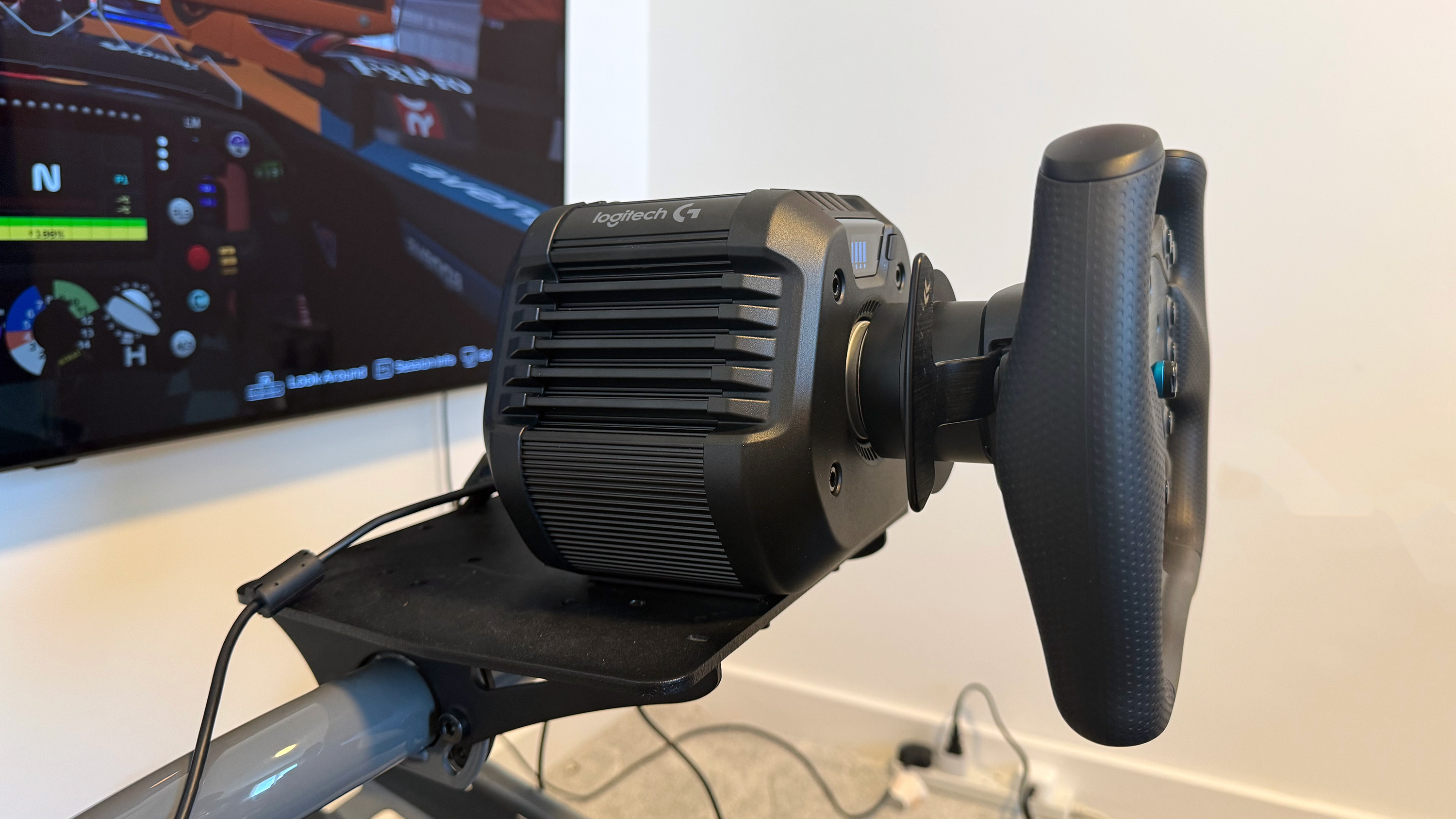
The software side is the Logitech RS50’s weakest point, though how impactful it is will vary from player to player. It’s clear this is intended to be as plug-and-play a setup as possible. As a result, compared to the likes of a sim racing specialist like MOZA, the range of tinkering and tuning options available in the G Hub app is noticeably limited. What is available will be enough for most casual players, and I didn’t personally want for much more, but I can imagine experienced racers feeling a little out of the loop.
It gets my seal of approval as a superb middle-ground racing wheel.
Game compatibility is often a sticking point for new steering wheel releases, and while I did run into a few hiccups with the Logitech RS50 in its native mode, these were quickly resolved by using the onboard controls and screen to switch to G Pro compatibility mode. This essentially spoofs the input to whichever game you’re playing, telling it to use the button mapping and settings of the brand’s more established wheel. It meant I was always able to have my inputs pre-mapped (the likes of which can’t be said for rivals like the Revosim RS Pure), and I didn’t notice any knock-on effects in performance when running in G Pro compatibility mode.
Should you buy the Logitech RS50?
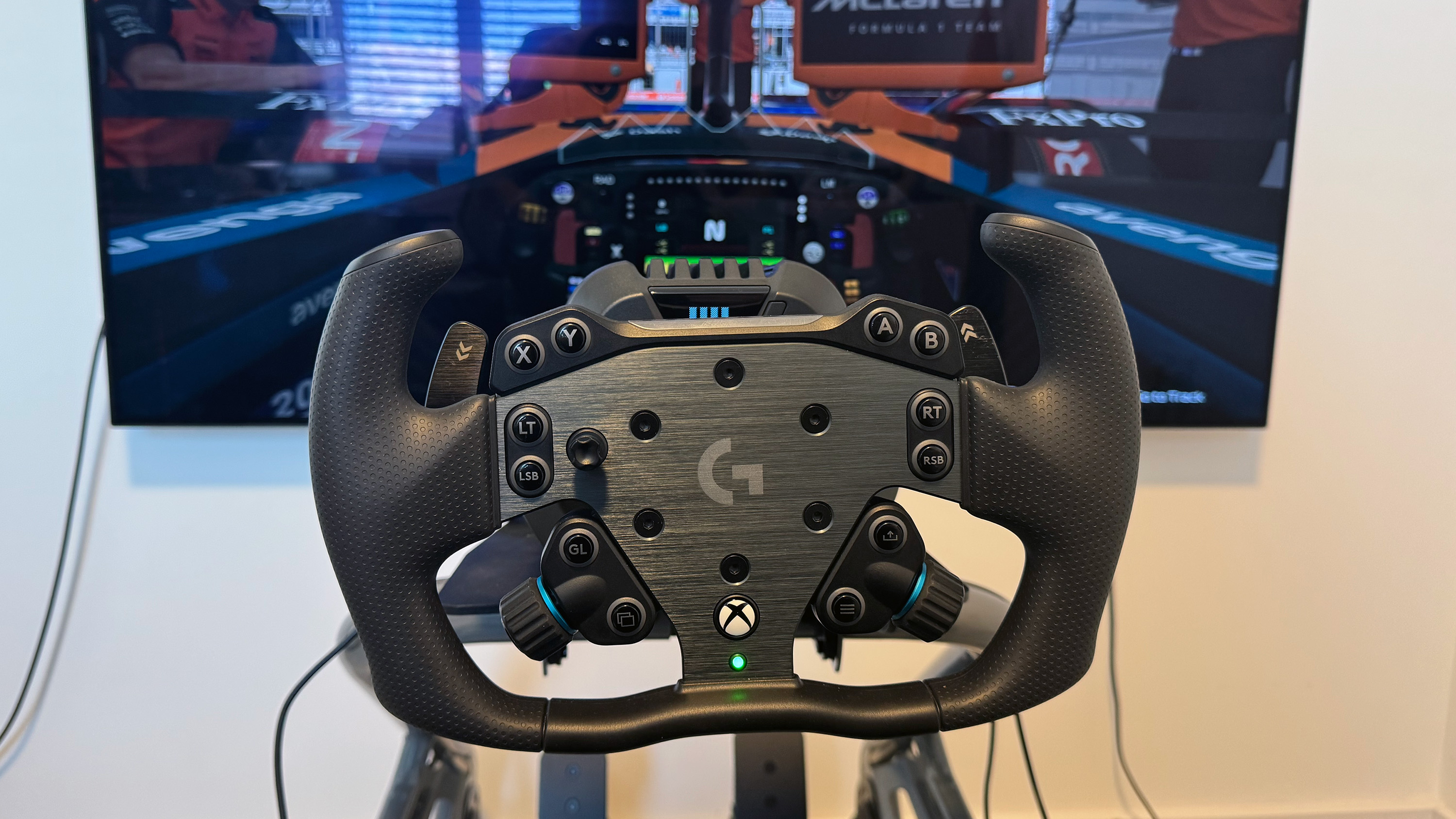
I said the RS50 was my favorite wheelbase a few paragraphs ago, so it should come as no surprise that it gets my seal of approval as a superb middle-ground racing wheel. If you’re looking for a direct drive step up from something like Logitech’s own G923, it ticks just about every box. 8Nm of power is plenty, particularly when it’s delivered as reliably as it is here, with the added immersive bonus offered by TRUEFORCE in some titles. Build quality is excellent, there’s an expanding ecosystem of add-ons, including those impressive load cell RS Pedals, and it’ll play nice with consoles too if you grab the right edition.
Assuming you want the full set, firstly, add the components to the cart individually because it’ll save you money over the RS System bundle. You’re still looking at something around $600/£500 total (plus an extra $159/£119 for some pedals) so the RS50 is not cheap, but it is excellent value for what you get in return and will hold its own for plenty of years to come. No, you aren’t given the same level of granular tuning control like you would with a more focused sim racing brand, and you might need to jump between onboard compatibility modes to have your buttons automatically mapped from title to title, but for casual sim racers, the Logitech RS50 is going to be particularly hard to beat.
How I tested the Logitech RS50
I used the PC version of the RS50 wheelbase and paired it with an existing RS Wheel Hub and RS Track Wheel. For pedals, I used the Logitech RS Pedals primarily with the default elastomer configuration as it is delivered in the box, though I did experiment with different combinations. Throughout testing, it was mounted to a Playseat Trophy Logitech G Edition using the supplied hardware. I tried a range of games, including F1 25, Forza Motorsport, and RaceRoom, testing both RS and G Pro compatibility modes.
For more on how we test the latest controllers, check out the GamesRadar+ Hardware Policy.
For more on simulator hardware, take a look at the best PS5 steering wheel, the best Xbox steering wheel, and the best joysticks.

Alex is a streamer who has been creating gaming content for over a decade, streaming on Twitch regularly across the last five years. With a degree in film and a background in sports media, you'll find him jumping between 60,000 seat stadiums and his Animal Crossing island (where he's growing pears, in case you were wondering).
You must confirm your public display name before commenting
Please logout and then login again, you will then be prompted to enter your display name.
